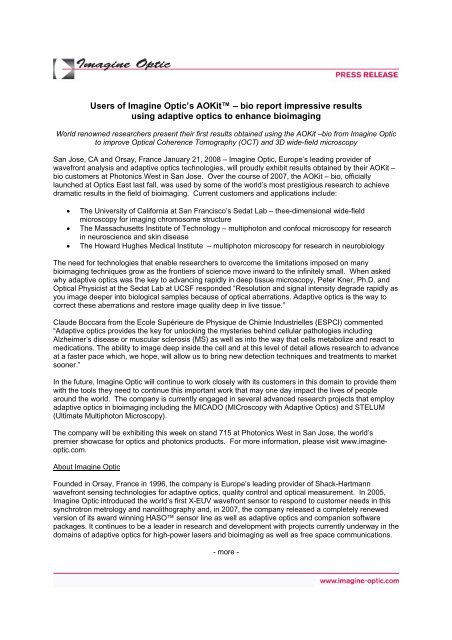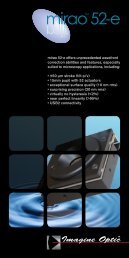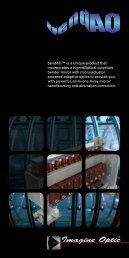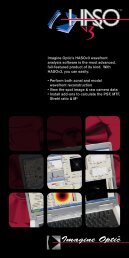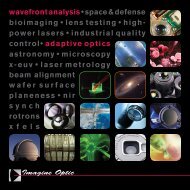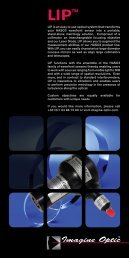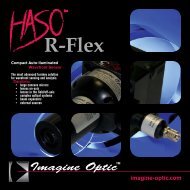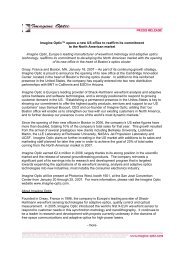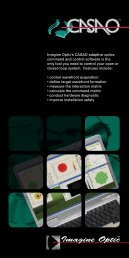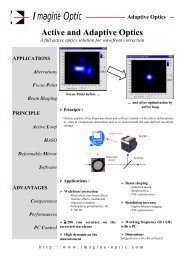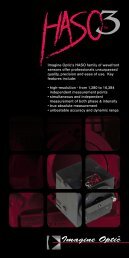to read the press release. - Imagine Optic
to read the press release. - Imagine Optic
to read the press release. - Imagine Optic
Create successful ePaper yourself
Turn your PDF publications into a flip-book with our unique Google optimized e-Paper software.
Users of <strong>Imagine</strong> <strong>Optic</strong>’s AOKit – bio report im<strong>press</strong>ive results<br />
using adaptive optics <strong>to</strong> enhance bioimaging<br />
World renowned researchers present <strong>the</strong>ir first results obtained using <strong>the</strong> AOKit –bio from <strong>Imagine</strong> <strong>Optic</strong><br />
<strong>to</strong> improve <strong>Optic</strong>al Coherence Tomography (OCT) and 3D wide-field microscopy<br />
San Jose, CA and Orsay, France January 21, 2008 – <strong>Imagine</strong> <strong>Optic</strong>, Europe’s leading provider of<br />
wavefront analysis and adaptive optics technologies, will proudly exhibit results obtained by <strong>the</strong>ir AOKit –<br />
bio cus<strong>to</strong>mers at Pho<strong>to</strong>nics West in San Jose. Over <strong>the</strong> course of 2007, <strong>the</strong> AOKit – bio, officially<br />
launched at <strong>Optic</strong>s East last fall, was used by some of <strong>the</strong> world’s most prestigious research <strong>to</strong> achieve<br />
dramatic results in <strong>the</strong> field of bioimaging. Current cus<strong>to</strong>mers and applications include:<br />
• The University of California at San Francisco’s Sedat Lab – <strong>the</strong>e-dimensional wide-field<br />
microscopy for imaging chromosome structure<br />
• The Massachusetts Institute of Technology – multipho<strong>to</strong>n and confocal microscopy for research<br />
in neuroscience and skin disease<br />
• The Howard Hughes Medical Institute – multipho<strong>to</strong>n microscopy for research in neurobiology<br />
The need for technologies that enable researchers <strong>to</strong> overcome <strong>the</strong> limitations imposed on many<br />
bioimaging techniques grow as <strong>the</strong> frontiers of science move inward <strong>to</strong> <strong>the</strong> infinitely small. When asked<br />
why adaptive optics was <strong>the</strong> key <strong>to</strong> advancing rapidly in deep tissue microscopy, Peter Kner, Ph.D. and<br />
<strong>Optic</strong>al Physicist at <strong>the</strong> Sedat Lab at UCSF responded “Resolution and signal intensity degrade rapidly as<br />
you image deeper in<strong>to</strong> biological samples because of optical aberrations. Adaptive optics is <strong>the</strong> way <strong>to</strong><br />
correct <strong>the</strong>se aberrations and res<strong>to</strong>re image quality deep in live tissue.”<br />
Claude Boccara from <strong>the</strong> Ecole Supérieure de Physique de Chimie Industrielles (ESPCI) commented<br />
“Adaptive optics provides <strong>the</strong> key for unlocking <strong>the</strong> mysteries behind cellular pathologies including<br />
Alzheimer’s disease or muscular sclerosis (MS) as well as in<strong>to</strong> <strong>the</strong> way that cells metabolize and react <strong>to</strong><br />
medications. The ability <strong>to</strong> image deep inside <strong>the</strong> cell and at this level of detail allows research <strong>to</strong> advance<br />
at a faster pace which, we hope, will allow us <strong>to</strong> bring new detection techniques and treatments <strong>to</strong> market<br />
sooner.”<br />
In <strong>the</strong> future, <strong>Imagine</strong> <strong>Optic</strong> will continue <strong>to</strong> work closely with its cus<strong>to</strong>mers in this domain <strong>to</strong> provide <strong>the</strong>m<br />
with <strong>the</strong> <strong>to</strong>ols <strong>the</strong>y need <strong>to</strong> continue this important work that may one day impact <strong>the</strong> lives of people<br />
around <strong>the</strong> world. The company is currently engaged in several advanced research projects that employ<br />
adaptive optics in bioimaging including <strong>the</strong> MICADO (MICroscopy with Adaptive <strong>Optic</strong>s) and STELUM<br />
(Ultimate Multipho<strong>to</strong>n Microscopy).<br />
The company will be exhibiting this week on stand 715 at Pho<strong>to</strong>nics West in San Jose, <strong>the</strong> world’s<br />
premier showcase for optics and pho<strong>to</strong>nics products. For more information, please visit www.imagineoptic.com.<br />
About <strong>Imagine</strong> <strong>Optic</strong><br />
Founded in Orsay, France in 1996, <strong>the</strong> company is Europe’s leading provider of Shack-Hartmann<br />
wavefront sensing technologies for adaptive optics, quality control and optical measurement. In 2005,<br />
<strong>Imagine</strong> <strong>Optic</strong> introduced <strong>the</strong> world’s first X-EUV wavefront sensor <strong>to</strong> respond <strong>to</strong> cus<strong>to</strong>mer needs in this<br />
synchrotron metrology and nanolithography and, in 2007, <strong>the</strong> company <strong>release</strong>d a completely renewed<br />
version of its award winning HASO sensor line as well as adaptive optics and companion software<br />
packages. It continues <strong>to</strong> be a leader in research and development with projects currently underway in <strong>the</strong><br />
domains of adaptive optics for high-power lasers and bioimaging as well as free space communications.<br />
- more -
<strong>Imagine</strong> <strong>Optic</strong>s’ clients are among <strong>the</strong> world’s <strong>to</strong>p companies and include Sony, Nikon, <strong>the</strong><br />
Massachusetts Institute of Technology, MIT, Thomson, Zeiss, NASA, <strong>the</strong> U.S. Air Force, Essilor, Thales<br />
Aliena Space, <strong>the</strong> Howard Hughes Medical Institute, EADS, <strong>the</strong> European Sou<strong>the</strong>rn Observa<strong>to</strong>ry, <strong>the</strong><br />
University of California at San Francisco (UCSF), <strong>the</strong> European Space Agency (ESA), amongst o<strong>the</strong>rs. In<br />
2006, <strong>Imagine</strong> <strong>Optic</strong> realized a turnover of €2,4M and currently employs 23 highly qualified professionals<br />
in a variety of domains. If you would like <strong>to</strong> learn more about us, please visit www.imagine-optic.com.<br />
#####<br />
Members of <strong>the</strong> <strong>press</strong> are invited <strong>to</strong> contact Mark Zacharia at Elucido Partners by telephone at +33 (0)1<br />
46 28 03 13, by e-mail at mz@elucido-partners.net, or by post at 9 rue de Crussol, Paris, France.<br />
©2008 <strong>Imagine</strong> <strong>Optic</strong>. All rights reserved. <strong>Imagine</strong> <strong>Optic</strong>, HASO, GENAO, CASAO, SH-LTP, SLSys and<br />
e-Xplorer are trademarks of <strong>Imagine</strong> <strong>Optic</strong>. mirao is a trademark of <strong>Imagine</strong> Eyes®. O<strong>the</strong>r products and<br />
services are <strong>the</strong> trademarks and/or registered trademarks of <strong>the</strong>ir respective owners. Communications by<br />
Elucido Partners, Paris France www.elucido-partners.net.


